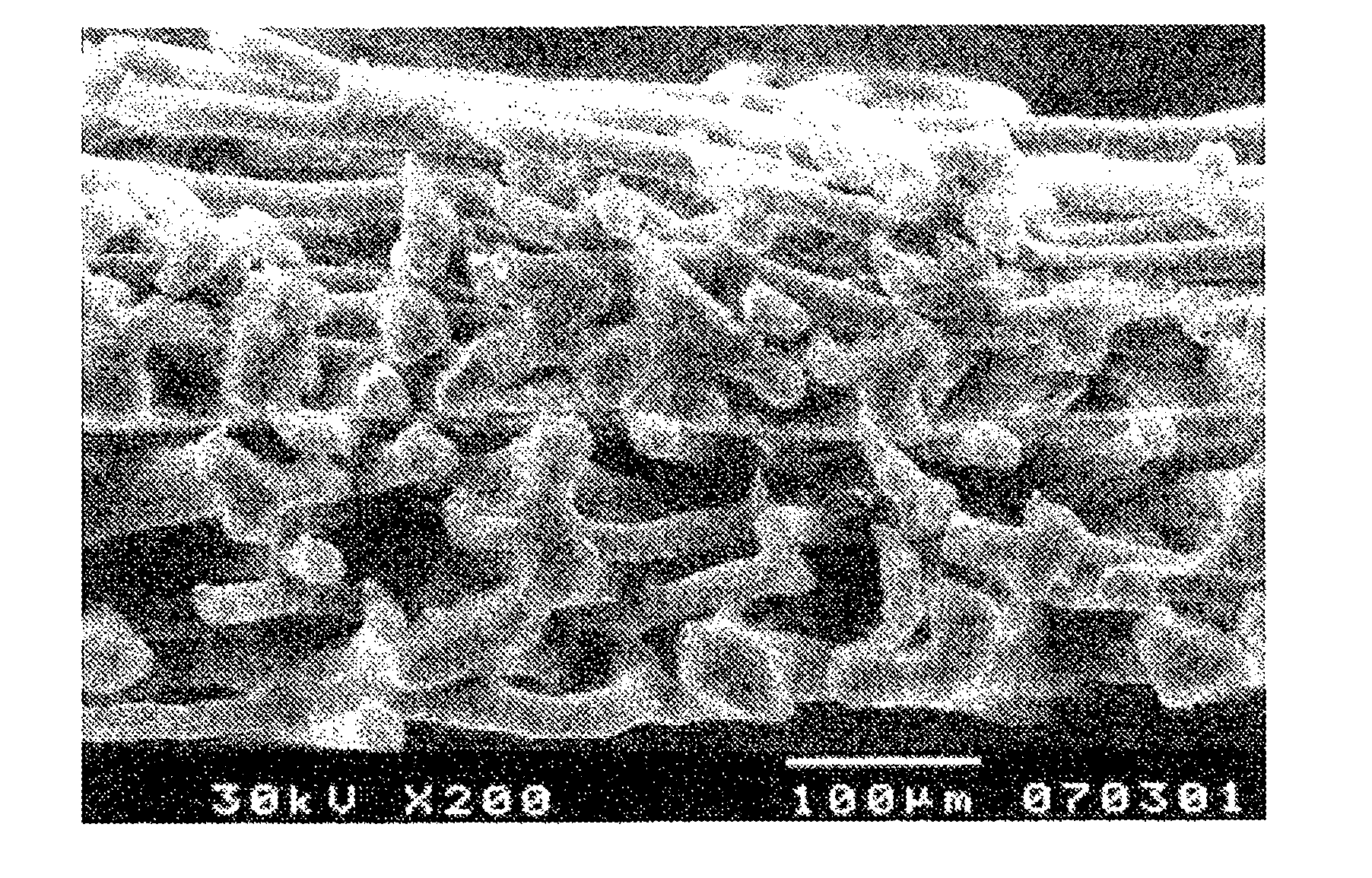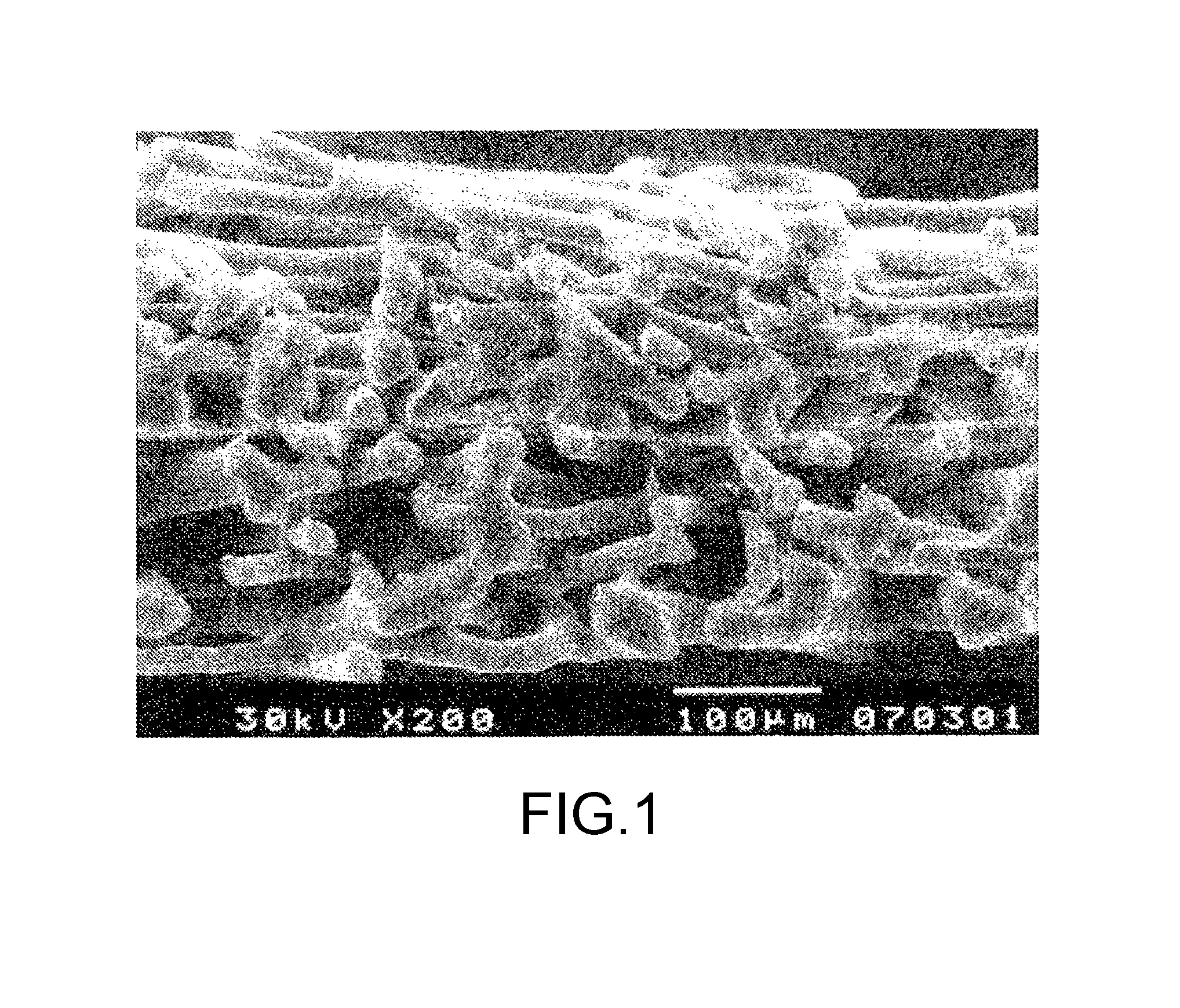Fibrous laminate containing ultrafine fibers and filter comprising same
a technology of ultrafine fibers and laminates, which is applied in the field of fiberlamination nonwoven fabrics and filters, can solve the problems of reducing processability, reducing operability and processability of laminates, and unattainable development of characteristics original to ultrafine fibers, and achieves low mechanical strength, high specific surface area, and high porosity.
- Summary
- Abstract
- Description
- Claims
- Application Information
AI Technical Summary
Benefits of technology
Problems solved by technology
Method used
Image
Examples
example 1
[0084]A 600 mm-wide nonwoven fabric of polypropylene ultrafine fibers was prepared by a melt-blown process by using a polypropylene resin (grade name: Achieve 6936) made by ExxonMobil Chemical Company. With regard to the obtained nonwoven fabric of polypropylene ultrafine fibers, a basis weight was 10 g / m2, a mean fiber diameter was 760 nm and a melting temperature was 154° C.
[0085]Next, a paper-making nonwoven fabric having a basis weight of 40 g / m2 and a width of 600 mm (in which, mixed fibers were used at 40 / 60 (w / w) in a ratio of mixing fibers for polyethylene terephthalate fibers having a fiber diameter of 14 μm and a sheath-core thermo-fusible conjugate fibers containing copolymerized polyester-polyethylene terephthalate as a sheath-core and having a fiber diameter of 16 μm) was arranged
[0086]The nonwoven fabric of polypropylene ultrafine fibers was used as a fibrous layer I and the paper-making nonwoven fabric was used as a fibrous layer II, and both were laminated, and heat-...
example 2
[0089]A polyurethane resin (grade name: T1190) made by DIC Bayer Polymer Ltd. was dissolved, at a concentration of 12.5% by mass, into a cosolvent of N,N-dimethylformamide and acetone (60 / 40 (w / w)) to adjust an electric field spinning solution.
[0090]Next, a carding process through-air nonwoven fabric having a basis weight of 40 g / m2 and a width of 1,000 mm (in which, a sheath-core thermo-fusible conjugate fibers containing high density polyethylene and polyethylene terephthalate as a sheath and a core and having a fiber diameter of 22 μm was used) was arranged as a base material nonwoven fabric, electric field spinning of the polyurethane solution was performed thereon to prepare a fibrous laminate formed of two layers of the base material nonwoven fabric and the polyurethane ultrafine fibers.
[0091]As conditions of electric field spinning, a 27 G needle was used, a solution feed rate per a single pore was adjusted to 2.0 mL / h, an applied voltage was adjusted to 35 kV, and a spinning...
example 3
[0098]Kynar (trade name) 3120 being a polyvinylidene fluoride-hexafluoropropylene (hereinafter, abbreviates as “PVDF-HFP”) resin made by Arkema Corporation was dissolved, at a concentration of 18% by mass, into a cosolvent of N,N-dimethylacetamide and acetone (60 / 40 (w / w)) to adjust an electric field spinning solution.
[0099]Next, a carding process through-air nonwoven fabric 1 having a basis weight of 20 g / m2 and a width of 1,100 mm (in which, sheath-core thermo-fusible conjugate fibers containing high density polyethylene and polypropylene as a sheath and a core and having a fiber diameter of 22 μm were used) was arranged as a base material nonwoven fabric, and electric field spinning of the PVDF-HFP solution was performed thereon to prepare a fibrous laminate formed of two layers of the base material nonwoven fabric and a PVDF-HFP layer of ultrafine fibers. As conditions of electric field spinning, a 27 G needle was used, a solution feed rate per a single pore was adjusted to 3.0 ...
PUM
| Property | Measurement | Unit |
|---|---|---|
| diameter | aaaaa | aaaaa |
| diameter | aaaaa | aaaaa |
| softening temperature | aaaaa | aaaaa |
Abstract
Description
Claims
Application Information
 Login to View More
Login to View More - R&D
- Intellectual Property
- Life Sciences
- Materials
- Tech Scout
- Unparalleled Data Quality
- Higher Quality Content
- 60% Fewer Hallucinations
Browse by: Latest US Patents, China's latest patents, Technical Efficacy Thesaurus, Application Domain, Technology Topic, Popular Technical Reports.
© 2025 PatSnap. All rights reserved.Legal|Privacy policy|Modern Slavery Act Transparency Statement|Sitemap|About US| Contact US: help@patsnap.com



